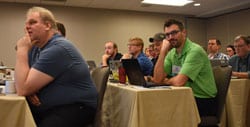
Case Study: Automating Processes at UMBC
Learn how UMBC used the TIER Grouper container to simplify patching, deployment, and scaling.

Software: InCommon Trusted Access Platform
Managing multiple resources and a large variety of access rights is often overwhelming. Whether you are on campus, a research organization or a company, finding solutions to simplify and centralize your access management is essential to your success.
This community knows identity and access challenges, such as bringing in a new freshman class every year, or enabling thousands of people to access hundreds of applications. Doing so quickly and efficiently is paramount. Oh, and it would be nice if it would have minimal impact on the help desk.
It starts with the InCommon Federation, which enables single sign-on for users to hundreds of resources. When paired with software provided through the community-developed InCommon Trusted Access Platform (in this case Shibboleth), users have single sign-on convenience to services by simply using their existing credentials. For service providers, this reduces the need to create log-ins and passwords, saving time and effort.
But that’s just for starters. Once students have credentials they now need access to learning management systems, coursework repositories, grades, bills, meal programs, and on and on. Grouper, a component of the InCommon Trusted Access Platform, provides solutions that are easy to manage and allow for decision-making at the appropriate level.
Consider, for example, the math department. Hundreds of students. Dozens of courses. Many faculty and staff. How do you ensure everyone has access to the right resources at the right time? Emails to central IT won’t cut it – it just isn’t scalable. And that’s just one academic department in the academic sea.
But imagine a scenario where faculty and staff have the ability to add and remove access when needed and appropriate. The InCommon Trusted Access Platform solves this problem with enterprise-level software (Grouper) that uses groups and allows for decentralized control of group membership. These groups can then be associated with classes, class materials, and all of the associated resources. The software is:

Learn how UMBC used the TIER Grouper container to simplify patching, deployment, and scaling.

LIGO chose Grouper as the manageable, scalable infrastructure of choice to handle the complex group access and organizational global relationships.

The Grouper Training Environment is a set of lesson plans, training exercises, and supporting Docker modules.

Grouper helps collaboration happen. You can use the software to set up groups, roles, and permissions for many purposes.
“We chose Grouper because of its flexibility, the number, and types of interfaces (web services interfaces in particular), and because we could see that it was being solidly developed and supported.”
Scott Koranda, senior scientist with the Laser Interferometer Gravitational Wave Observatory (LIGO) project. LIGO selected Grouper as the single place where the information about groups, memberships, and (eventually) roles would be housed and from which other pieces of the infrastructure could draw.